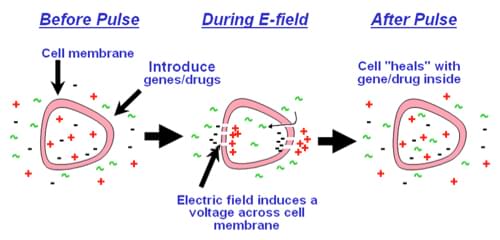All products and services are For Research Use Only and CANNOT be used in the treatment or diagnosis of disease.
Creative Biolabs offers optimized electroporation gene transfer service for modifying T cells genetically. As a non-viral gene transfer system, electroporation performs high transfection efficiency and low toxicity compared with other non-viral gene transfer methods used for primary lymphocytes, such as liposome. It can also accelerate gene transfer without the potential safety issues from viral vectors.

There are two classes of methods for DNA transfer: natural methods and artificial methods (including physical methods, chemical methods and electrical methods). Electroporation, along with electrofusion, belong to electrical methods. Electrical methods share similar mechanism: the reversible electropermeabilization of biological membranes. Electroporation employs high-voltage electrical pulse to introduce agents into cells. Just as shown in the figure, E-field (electric field) is used to introduce microscopic pores in biological membranes. Then these microscopic pores, electropores, allow different agents such as small molecules, ions to pass from one side of the membrane to the other. When a suitable pulse is given, the pores can reseal with molecules inside and the cells recover. Compare with some other gene transfer strategies, the approach of electroporation has several advantages: its process is fast and less costly. It is applied for a number of cell types and can treat various cells simultaneously. Moreover, by this method, high percentage of stable transformants can be produced. Considering these advantages, electroporation has various applications including: (1) to introduce exogenous DNA into bacterial protoplast, yeast protoplast, plant protoplast and animal cell line; (2) to increase efficiency of transfection or transformation of different cells; (3) to transform plant cells including wheat, tobacco, rice, maize with frequency up to 1%; (4) to introduce DNA into early embryo to produce transgenic animals; (5) to generate transient expression of molecular constructs. In terms of mammalian transgenesis, electroporation has been used to transfer exogenous DNA into cultured mammalian embryos at defined stages of development. Similarly, bovine blastocysts and fish species can also be genetically manipulated by the method of electroporation. Besides to facilitate gene transfer in both large and small animals, electroporation is reported to increase gene expression and improve immune response elicited to DNA vaccines.
The electroporation methods include:
The most popular strategies used for TCR gene transfer:
| ➤ | Viral vectors: |
Retroviral vectors Lentiviral vectors |
| ➤ | Electroporation |
References:
K.H.KHAN. Gene Transfer Technologies and their Applications: Roles in Human Diseases. ASIAN J. EXP. BIOL. SCI. VOl 1 (1) 2010:208-218.
To discuss your demands or to request a proposal, please contact us by .
For any technical issues or product/service related questions, please leave your information below. Our team will contact you soon.
 NEWSLETTER
NEWSLETTER
The latest newsletter to introduce the latest breaking information, our site updates, field and other scientific news, important events, and insights from industry leaders
LEARN MORE NEWSLETTER NEW SOLUTION
NEW SOLUTION
CellRapeutics™ In Vivo Cell Engineering: One-stop in vivo T/B/NK cell and macrophage engineering services covering vectors construction to function verification.
LEARN MORE SOLUTION NOVEL TECHNOLOGY
NOVEL TECHNOLOGY
Silence™ CAR-T Cell: A novel platform to enhance CAR-T cell immunotherapy by combining RNAi technology to suppress genes that may impede CAR functionality.
LEARN MORE NOVEL TECHNOLOGY NEW SOLUTION
NEW SOLUTION
Canine CAR-T Therapy Development: From early target discovery, CAR design and construction, cell culture, and transfection, to in vitro and in vivo function validation.
LEARN MORE SOLUTION